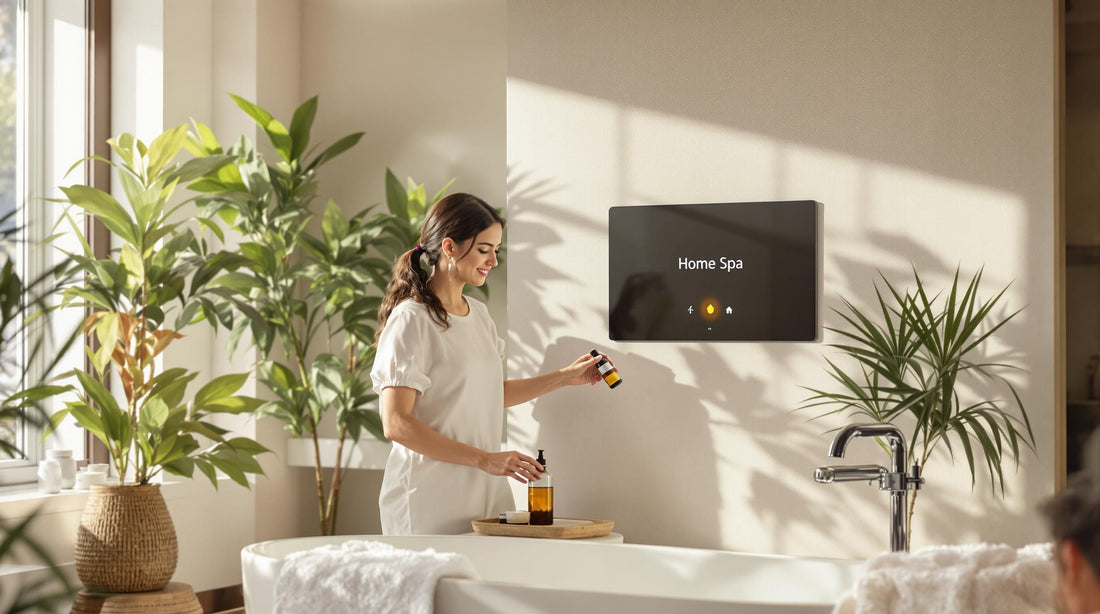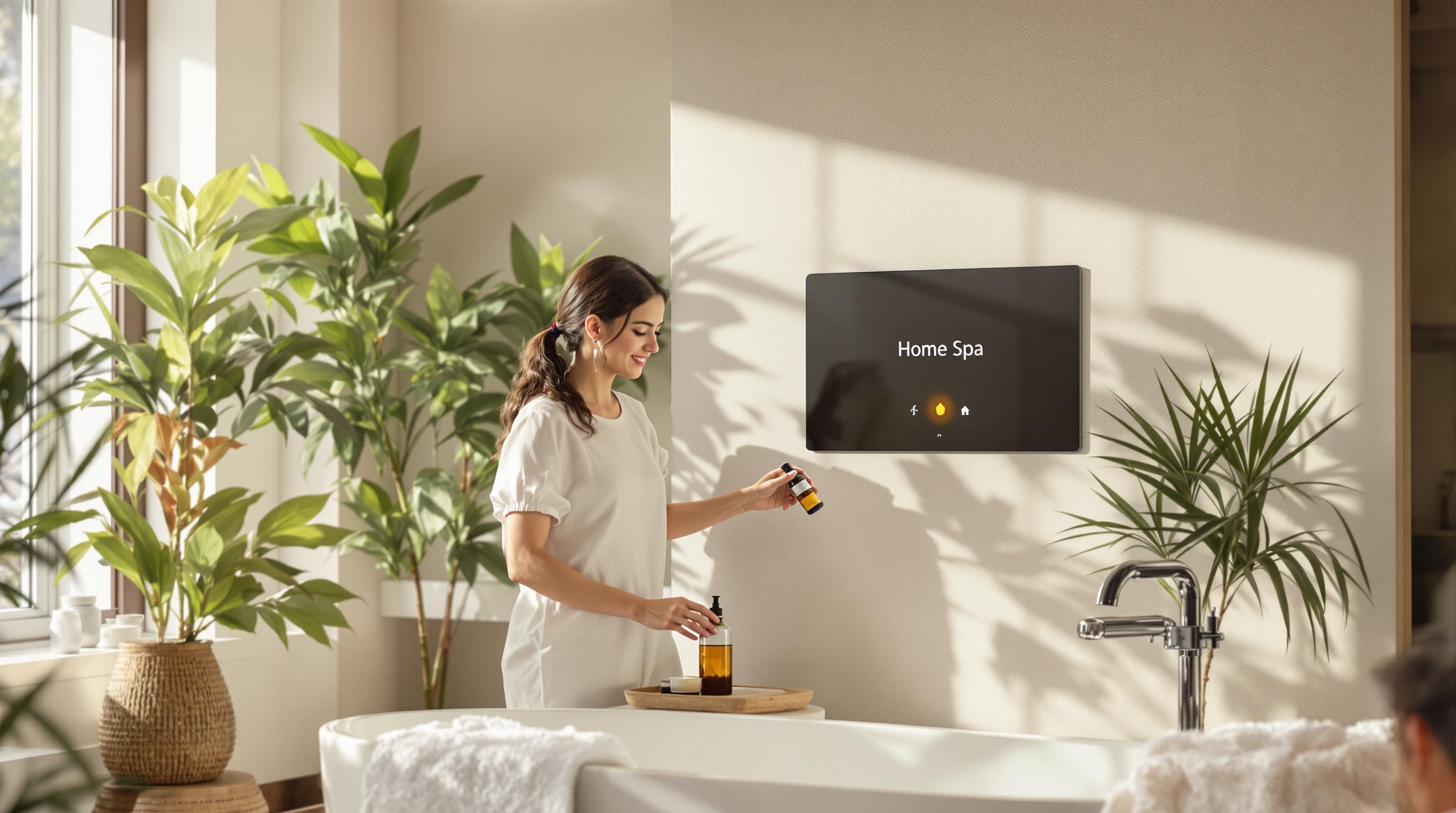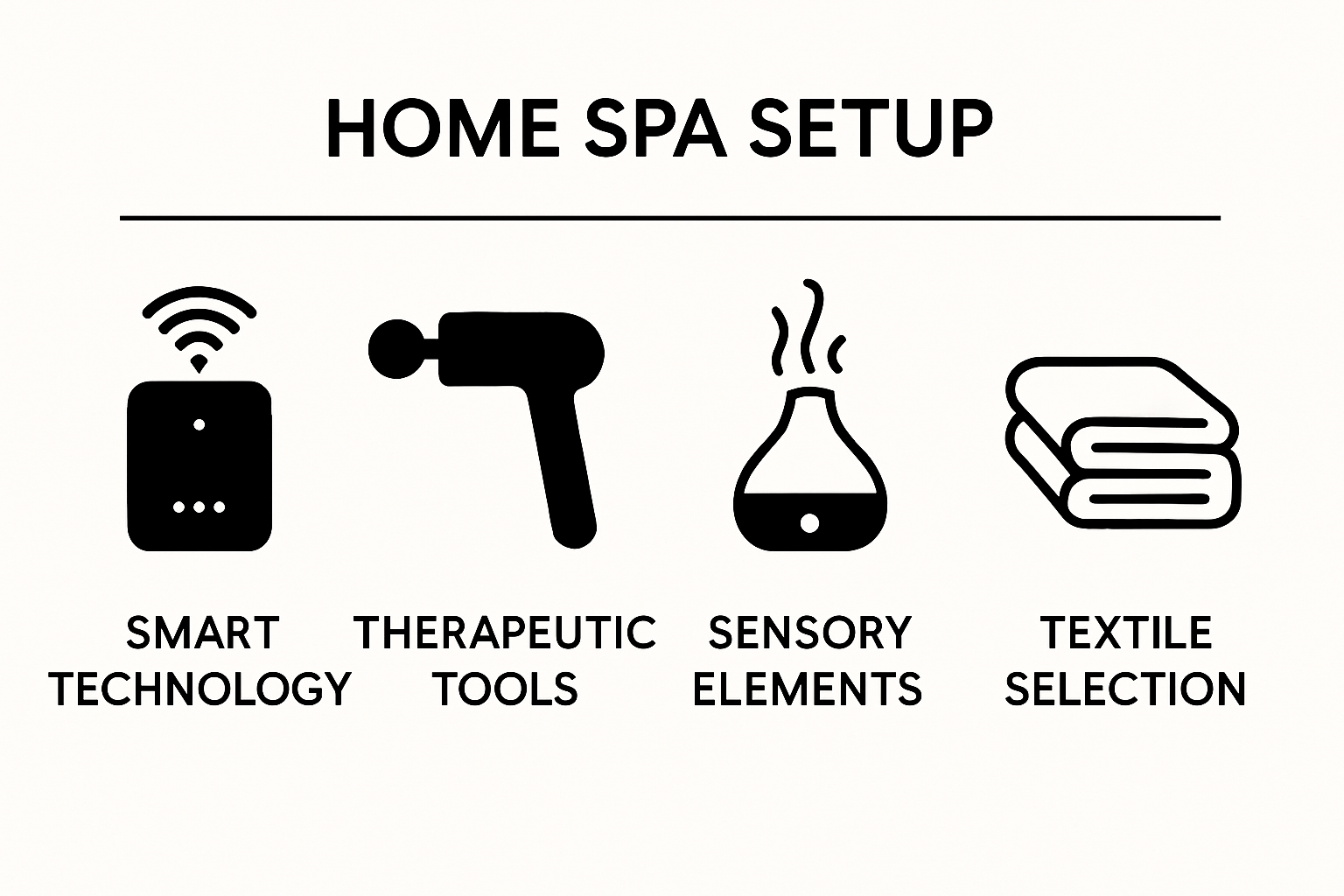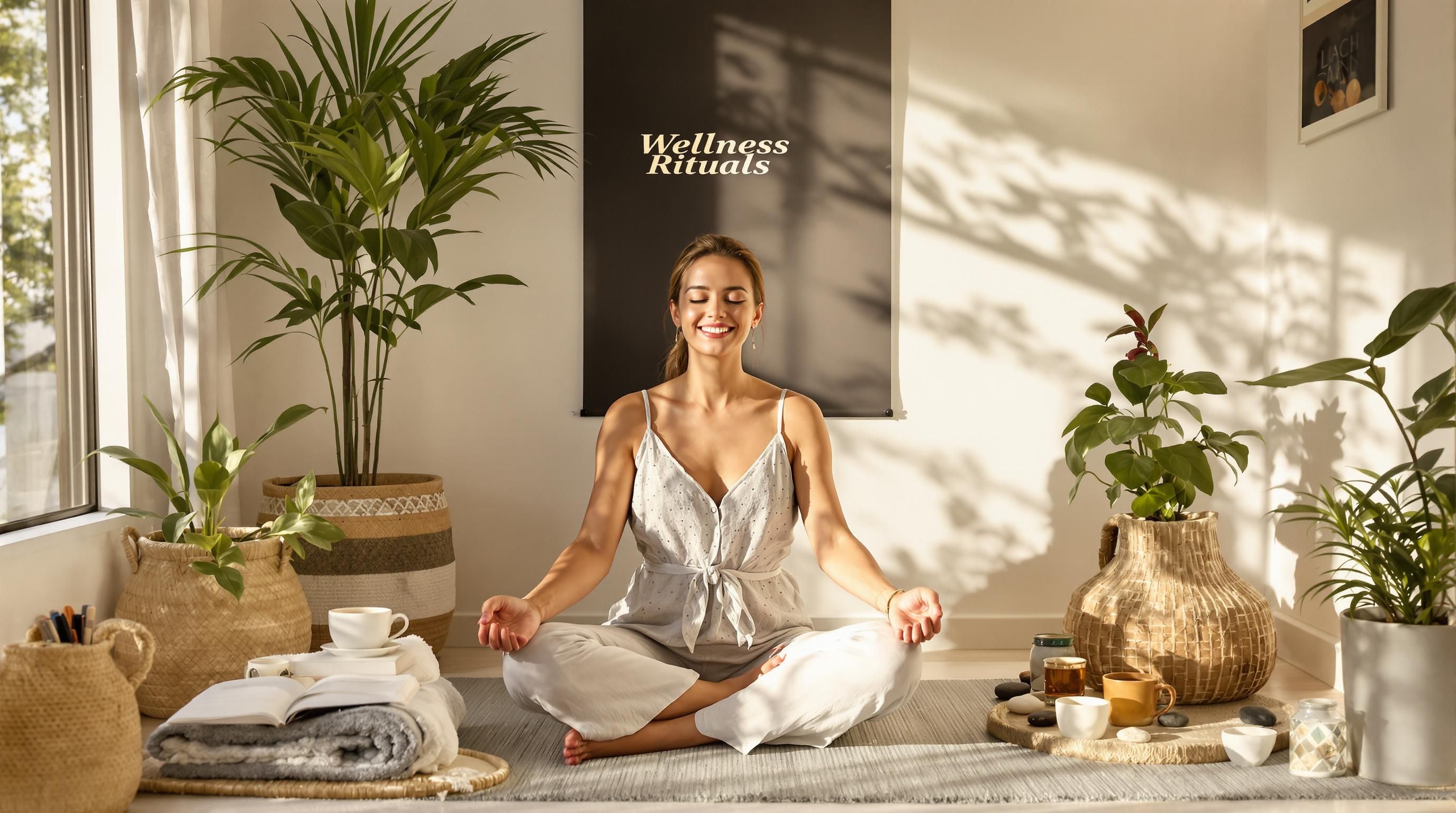
Transforming Your Home Spa: Wellness Tips for 2025

Creating a home spa is more than just a design trend these days. More people are turning spare rooms and bathrooms into healing retreats packed with high-tech features and personal touches. Here is something that might surprise you. Nearly 75 percent of homeowners surveyed in 2024 said that a fully sensory, tech-integrated spa was their top home upgrade goal. But the real transformation does not just come from fancy gadgets or candles. The secret is in how these personalized wellness spaces actually help you break stress cycles and improve your mental state day after day.
Table of Contents
- Essential Elements For Transforming Your Home Spa
- Creating A Sensory Wellness Environment
- Technological Integration For Enhanced Wellness
- Personalization And Adaptive Spaces
- Creating A Relaxation-Focused Spa Atmosphere
- Sensory Atmosphere Design
- Spatial Configuration And Comfort
- Psychological Wellness Triggers
- Integrating High-Quality Products For Ultimate Wellness
- Smart Technology And Health Monitoring
- Therapeutic Product Selection
- Holistic Wellness Integration
- Personalized Rituals And Routines For Lasting Benefits
- Understanding Personal Wellness Rhythms
- Designing Intentional Recovery Sequences
- Emotional And Psychological Integration
Quick Summary
| Takeaway | Explanation |
|---|---|
| Create a multisensory environment | Engage all five senses to enhance relaxation and healing. Incorporate elements like lighting, sound, and scent. |
| Integrate smart technology | Use devices that improve air quality, monitor health, and assist with relaxation. This enhances your overall spa experience. |
| Personalize your spa space | Adapt the design and elements to meet your unique wellness needs. Modular furniture and natural materials can be effective. |
| Develop intentional wellness rituals | Create routines that align with your personal stress patterns and physical needs, integrating mindfulness, hydrotherapy, and breathwork. |
| Utilize high-quality therapeutic products | Select items that provide tangible health benefits, like hydrotherapy systems and essential oil diffusers, to support overall well-being. |
Essential Elements for Transforming Your Home Spa
Transforming your home spa goes beyond simply adding a few decorative items. It requires a holistic approach that combines design, functionality, and wellness principles to create a truly rejuvenating personal sanctuary. Strategic design and intentional elements can turn an ordinary space into a transformative wellness retreat that supports physical and mental restoration.
Creating a Sensory Wellness Environment
The foundation of a successful home spa experience lies in understanding how environmental factors impact relaxation and healing. Research published in the International Journal of Environmental Research and Public Health highlights the critical role of multisensory design in creating therapeutic spaces. This means carefully curating elements that engage all five senses to promote deep relaxation and stress reduction.
Lighting plays a crucial role in setting the mood. Soft, adjustable lighting with warm color temperatures can help trigger the body’s relaxation response. Consider installing dimmable LED lights or using salt lamps that emit a gentle, soothing glow. Natural light integration through strategically placed windows or skylights can also enhance the spa atmosphere, providing a connection to the external environment.
Sound design is equally important. Incorporate acoustic elements that promote tranquility such as subtle water features, wind chimes, or a carefully curated playlist of ambient sounds. Acoustic research from wellness design experts suggests that specific sound frequencies can significantly reduce stress and promote mental clarity.
Technological Integration for Enhanced Wellness
Modern home spas are not just about aesthetics but also about integrating smart technologies that enhance the wellness experience. Consider incorporating air purification systems that maintain optimal indoor air quality. Humidity control mechanisms can create the perfect environment for saunas, steam rooms, or relaxation zones.
Water features are another transformative element. Whether it’s a compact cold plunge tub, a compact hydrotherapy shower, or a carefully designed water wall, these elements can provide therapeutic benefits. The sound of flowing water combined with temperature variations can stimulate circulation, reduce muscle tension, and create a multisensory relaxation experience.
Personalization and Adaptive Spaces
The most effective home spa spaces are those that adapt to individual needs. Modular furniture, adjustable lighting, and flexible design elements allow the space to transform based on specific wellness goals. Consider incorporating movable partitions, versatile seating options, and storage solutions that can quickly transition the space from a meditation area to a massage zone.
Textural elements also play a significant role in transforming your home spa. Incorporate natural materials like bamboo, stone, and organic fabrics that provide tactile comfort and create a sense of grounding. Soft towels, ergonomic cushions, and temperature-responsive materials can enhance the overall sensory experience.
Transforming your home spa is an art of creating a personalized wellness sanctuary that speaks directly to your physical and emotional needs. By thoughtfully integrating environmental design, technology, and sensory elements, you can develop a space that not only looks beautiful but actively contributes to your holistic well-being.
To help you quickly compare different key elements for an effective home spa, here’s a summary table outlining their purpose and benefits:
| Element | Example Features | Purpose/Benefit |
|---|---|---|
| Sensory Environment | Lighting, scent, sound, natural textures | Promotes deep relaxation, reduces stress |
| Smart Technology | Air purification, humidity control, health monitors | Enhances experience, improves air/health quality |
| Water Features | Cold plunge, hydrotherapy shower, water wall | Stimulates circulation, reduces muscle tension |
| Modular/Adaptive Design | Movable furniture, partitions | Customizable space for varied wellness activities |
| Natural Materials & Textures | Bamboo, stone, organic fabrics, ergonomic cushions | Grounding, tactile comfort, enhanced sensory appeal |
Creating a Relaxation-Focused Spa Atmosphere
Creating a relaxation-focused spa atmosphere requires more than just aesthetic considerations. It demands a thoughtful approach that engages multiple sensory experiences and psychological triggers to promote deep relaxation and mental restoration. Intentional design becomes the cornerstone of transforming an ordinary space into a sanctuary of tranquility.
Sensory Atmosphere Design
According to the Skin Science Institute, crafting a truly relaxing environment involves strategic manipulation of sensory inputs. Lighting plays a critical role in this process. Soft, warm-toned lights can immediately signal the body to transition into a relaxation state. Consider using dimmable fixtures, salt lamps, or carefully placed candles that emit a gentle, amber glow.
Sound design is equally crucial in creating a relaxation-focused atmosphere. Acoustic elements should be carefully curated to promote mental calm. This might include subtle background sounds like gentle water features, soft instrumental music, or nature-inspired soundscapes. The goal is to create an auditory environment that helps quiet the mind and reduce stress responses.
Aromatherapy emerges as a powerful tool in spa atmosphere creation. Self-Help Education advises incorporating calming scents like lavender, chamomile, or eucalyptus through essential oil diffusers or strategically placed natural botanical elements. These fragrances can trigger physiological relaxation responses, lowering heart rate and reducing anxiety.
Spatial Configuration and Comfort
The physical layout of your home spa significantly impacts its ability to induce relaxation. Research from bbspa_Group emphasizes the importance of creating zones that facilitate different relaxation experiences. This might involve creating distinct areas for meditation, hydrotherapy, and rest.
Ergonomic considerations are paramount. Choose furniture and accessories that support complete physical relaxation. This includes supportive yet comfortable loungers, soft textural elements like plush towels and cushions, and temperature-adaptive materials that respond to body heat. The goal is to create an environment where physical comfort naturally promotes mental relaxation.
Psychological Wellness Triggers
Beyond physical design, a truly relaxation-focused spa atmosphere must address psychological wellness. Color psychology plays a significant role in this approach. Soft, muted colors like sage green, pale blue, and warm neutrals can create a sense of calm and spaciousness. These colors should be incorporated through wall treatments, textiles, and decorative elements.
Natural elements are powerful psychological triggers for relaxation. Incorporate live plants, natural stone elements, or wooden accessories that create a connection to the natural world. These elements not only enhance visual appeal but also subconsciously signal a sense of peace and grounding.
Technology can be strategically used to enhance relaxation. Consider integrating smart home features that allow for seamless control of lighting, sound, and temperature. Automated systems that can create preset relaxation modes can transform your spa experience, allowing for instant transition into a state of calm.
Creating a relaxation-focused spa atmosphere is an art of balance. It requires understanding how sensory experiences, spatial design, and psychological triggers work together to create a holistic environment of tranquility. By approaching your home spa as a carefully crafted wellness sanctuary, you can design a space that offers genuine respite from the external world.
Here’s a table summarizing the main sensory elements and their calming effects in a relaxation-focused spa atmosphere:
| Sensory Element | Methods/Features | Calming Effect |
|---|---|---|
| Lighting | Dimmable fixtures, salt lamps, candles | Triggers relaxation, soothes the mind |
| Sound | Water features, music, nature soundscapes | Promotes mental calm, lowers stress |
| Scent | Essential oils (lavender, chamomile, eucalyptus), plants | Reduces anxiety, lowers heart rate |
| Touch | Plush towels, cushions, supportive loungers | Improves comfort, aids mental rest |
| Color | Soft greens, blues, neutrals | Creates peaceful, spacious feeling |
| Nature Elements | Live plants, wood, stone | Grounds senses, signals tranquility |
Integrating High-Quality Products for Ultimate Wellness
 Creating an ultimate wellness experience requires more than just a beautifully designed space. Strategic product selection becomes the cornerstone of transforming your home spa into a comprehensive health and recovery environment. The right products can elevate your wellness journey from simple relaxation to a holistic approach to personal health maintenance.
Creating an ultimate wellness experience requires more than just a beautifully designed space. Strategic product selection becomes the cornerstone of transforming your home spa into a comprehensive health and recovery environment. The right products can elevate your wellness journey from simple relaxation to a holistic approach to personal health maintenance.
Smart Technology and Health Monitoring
Research exploring wearable health monitoring systems highlights the emerging trend of integrating intelligent technology into personal wellness spaces. Modern home spa environments are no longer just about relaxation but about active health management. Consider incorporating smart devices that can track vital signs, monitor stress levels, and provide real-time feedback about your physiological responses.
Wearable technology can seamlessly integrate with your spa experience, offering insights into heart rate variability, temperature regulation, and overall stress levels. These devices can help you understand how different spa treatments and relaxation techniques impact your body’s recovery processes. Advanced sensors can track everything from muscle tension to respiratory patterns, allowing for a more personalized wellness approach.
Therapeutic Product Selection
A comprehensive study on health interventions demonstrated the significant impact of targeted wellness products. When selecting items for your home spa, prioritize products that offer measurable health benefits. This means looking beyond aesthetic appeal and focusing on items that provide genuine therapeutic value.
Hydrotherapy accessories like specialized massage jets, temperature-controlled water systems, and ergonomic support elements can transform ordinary bathing experiences into comprehensive recovery sessions. Look for products with scientifically validated design principles that support muscle recovery, improve circulation, and promote overall physical restoration.
Holistic Wellness Integration
Research focusing on comprehensive health education emphasizes the importance of a multifaceted approach to wellness. Your product selection should reflect this holistic perspective. This means choosing items that address not just physical recovery but also mental and emotional well-being.
Consider incorporating products that engage multiple sensory experiences. Essential oil diffusers with precise temperature and dispersion controls, sound therapy systems that can generate specific healing frequencies, and lighting solutions that mimic natural circadian rhythms can all contribute to a more comprehensive wellness experience.
Textile products also play a crucial role. Select materials that offer therapeutic benefits such as temperature-regulating fabrics, compression elements that support muscle recovery, and antimicrobial surfaces that maintain a clean, healthy environment.
The art of integrating high-quality products for ultimate wellness lies in understanding that each item should serve a specific purpose. Your home spa is not about accumulating expensive gadgets but about creating a carefully curated ecosystem of health-supporting technologies and therapeutic tools.
By thoughtfully selecting products that offer genuine health benefits, monitor your physiological responses, and support holistic recovery, you transform your home spa from a simple relaxation space into a personalized wellness sanctuary. The goal is to create an environment that actively contributes to your physical, mental, and emotional restoration.
Personalized Rituals and Routines for Lasting Benefits
Creating a home spa experience extends far beyond physical design and product selection. Personalized wellness rituals represent the most profound method of transforming occasional relaxation into a sustainable approach to holistic health. The key lies in developing intentional routines that resonate with your individual physical and emotional needs.
Understanding Personal Wellness Rhythms
Research published in the International Journal of Environmental Research and Public Health highlights the critical importance of individualized wellness routines. These personalized approaches are not one-size-fits-all solutions but carefully crafted experiences that adapt to your unique lifestyle, stress patterns, and physiological requirements.
Begin by conducting a personal wellness assessment. This involves understanding your specific stress triggers, physical tension points, and emotional recovery needs. Some individuals might require more intensive hydrotherapy, while others might benefit from extended meditation or breathwork sessions. The goal is to create a ritual that feels natural and supportive rather than prescriptive or forced.
Consider tracking your responses to different wellness activities. Maintain a journal documenting how various spa techniques impact your energy levels, stress reduction, and overall mental clarity. This self-reflective approach allows you to continuously refine and personalize your home spa experience.
Designing Intentional Recovery Sequences
According to the American Psychological Association, consistent and meaningful routines promote psychological resilience and long-term motivation. Your home spa ritual should incorporate a structured yet flexible sequence that addresses multiple dimensions of wellness.
A comprehensive recovery ritual might include progressive stages. Start with a physical preparation phase involving gentle stretching or foam rolling to release muscle tension. Follow this with a hydrotherapy session that could involve alternating temperature experiences—perhaps a warm soak followed by a brief cold plunge to stimulate circulation. Integrate breathwork or meditation to transition between physical and mental recovery stages.
Technology can support ritual consistency. Utilize smart home systems or wellness apps that help you track and maintain your personalized routine. These tools can provide gentle reminders, track your progress, and offer modifications based on your physiological data.
Emotional and Psychological Integration
True wellness rituals transcend physical recovery and touch the realm of emotional restoration. Your home spa routine should include elements that nurture psychological well-being. This might involve incorporating mindfulness practices, journaling during or after your spa session, or using sound therapy techniques that help process emotional stress.
Consider developing seasonal variations in your wellness ritual. Our bodies and minds have different needs throughout the year, and your home spa routine can dynamically adapt. A summer ritual might focus more on cooling and energizing techniques, while a winter routine could emphasize deep restoration and warmth.
The art of creating personalized wellness rituals is about listening to your body and responding with compassion. It’s not about achieving perfection but about developing a sustainable, enjoyable approach to self-care that evolves with you.
By approaching your home spa as a dynamic, personalized wellness ecosystem, you transform occasional relaxation into a profound journey of physical and emotional recovery. Your ritual becomes a powerful tool for maintaining balance, reducing stress, and supporting your overall well-being in an increasingly demanding world.

Frequently Asked Questions
What are the essential elements for transforming a home spa?
Transforming a home spa requires creating a multisensory environment, integrating smart technology, personalizing the space to your needs, and developing intentional wellness rituals.
How can I create a relaxation-focused atmosphere in my home spa?
To create a relaxing atmosphere, use soft lighting, soothing sounds, calming scents, and comfortable furnishings. Incorporate natural elements to enhance the sense of tranquility and grounding.
What high-quality products should I use for ultimate wellness in my home spa?
Select products that offer measurable health benefits, such as hydrotherapy systems, essential oil diffusers, advanced temperature control systems, and ergonomic furnishings designed for comfort and recovery.
How can I develop personalized wellness rituals in my home spa?
Start by assessing your personal wellness rhythms and identifying your stress triggers. Create structured routines that incorporate physical, mental, and emotional recovery elements, and adapt them seasonally to meet changing needs.
Upgrade Your Home Spa Experience Today
You have spent time learning how a personalized spa retreat can transform your daily life, offering deep relaxation, smart technology, and wellness rituals tailored to you. Yet, creating this sanctuary at home can be challenging if you do not have the right tools or products. With stress relief and mental clarity as top priorities, many find it frustrating to search for trusted solutions that bring real therapeutic benefits.

Best Life Sauna helps bridge the gap between inspiration and reality. Experience the powerful impact of premium infrared or traditional saunas, rejuvenating cold plunge tubs, and high-quality accessories that support your multisensory spa environment. Discover how leading wellness technology can be seamlessly integrated into your home routine while enjoying exclusive offers like free shipping on orders over $200. Explore the full range of wellness solutions at Best Life Sauna now and take the first step toward building your personalized wellness sanctuary. Your best life starts with a decision to invest in yourself today.

